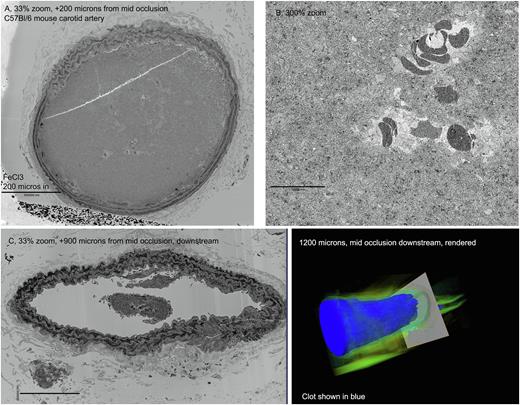Abstract
Hemostasis in veins and arteries has been assumed to be different processes, e.g., white vs. red clots. We took the unbiased experimental approaches of 3D EM across full clot volumes and high-resolution heat mapping of platelet activation state to probe for commonalities and variations using controlled mouse models. Remarkably, the thrombi formed, 5 min post-puncture, in the jugular vein and femoral artery showed considerable consistency in organization. There were vaulted cavities within the puncture wound and apparent extravascular capping of the puncture hole to produce bleeding cessation. Notable differences in the venous thrombi were a greater activation of platelets lining the surfaces of the vaulted columns, an outcome that we attribute to lowr flow rates resulting in the longer retention of activating signals, and in the "hanging drop” nature of the arterial thrombi anchored to the extrema with an outward, extravascular bulge of the thrombus. We attribute these variations to arterial vessel wall properties and higher flow rates. At 20 min post-puncture, the intravascular crown of the venous wound thrombi was enriched in loosely adherent platelets in a low activation state. Similarly, the outer portion of the intravascular arterial thrombus was rich in low activation platelets including obviously discoid platelets. Strikingly, the arterial thrombus was subject to rebleeding and ate 20 min displayed fractured extravascular features indicative of an unstable clot.
The puncture wound thrombi form in the relatively small volume of the immediate wound site. In contrast, occlusive clots fill the cylindrical volume of the vessel. To us, the overall structure of the wound thrombi suggested a predictive hypothesis for induced occlusive clotting. We propose that 1) the exposed intima lining the arterial vessel wall provides a cylindrical substratum for the generation of a tightly adherent platelet layer anchoring the forming clot and 2) the central volume of the clot resembles the intravascular crown of the puncture wound thrombus. Hence, the prediction of a central volume of the occlusive clot consisting of loosely adherent to discoid shaped platelets. That was result found for FeCl3 induced femoral clots by wide area-TEM (WA-TEM) i.e., a central volume rich in discoid shaped platelet and few red blood cells were trapped in the tightly adherent rim of the clot.. Using sequential block face SEM, we have begun to image and volume render carotid clots by sequential block face SEM. Analysis of 5,000 sequential images from the downstream half of the carotid clot, showed that the structure gradually tapered in a conical manner and contains few red blood cells. We propose that there are indeed organizational themes shared by the puncture wound thrombus in venous or arterial settings and the occlusive clot in which vascular damage is restricted to the endothelial cell layer.
Work was supported by NIH grants (BS) R01 HL155519 and P20 HL146373 (Joel Bennett, principal investigator), R35 HL150118 (SWW) and by intramural NIBIB research program (RDL).
Disclosures
No relevant conflicts of interest to declare.
Author notes
Asterisk with author names denotes non-ASH members.


This feature is available to Subscribers Only
Sign In or Create an Account Close Modal